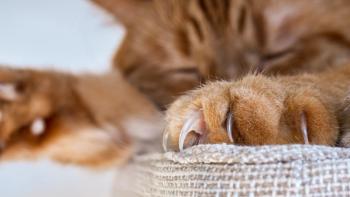
- dvm360 November 2019
- Volume 50
- Issue 11
Journal Scan: Community engagement encourages effective management of unowned cats
Trap-Neuter-Return programs for unowned cats may fail because local community members arent involved. Social efforts need to join medical efforts, say these UK researchers.
An overpopulation of unowned cats presents significant problems in urban areas across the globe. These free-roaming cats cause a general nuisance and raise animal welfare,1,3 public health,2,4 and environmental concerns.3 Human behavior, such as abandoning unneutered cats and unwanted litters, is often the main driver of unowned cats in urban areas.5
Trap-neuter-release (TNR) programs are a common solution to this overpopulation. However, TNR is time- and resource-intensive. Despite this intense effort, successes that are achieved can be short-lived without community engagement in managing the unowned cats. TNR programs “are at risk of becoming insignificant in the long-term if human behaviors and attitudes within the community are not taken into account,” wrote the authors of a Frontiers in Veterinary Science publication on TNR.6
Those authors described the development and application of a social framework within the context of a TNR campaign. This framework, they wrote, helps identify the key social factors that can be barriers to effective management of unowned cats. Targeting and addressing these factors not only increases the likelihood of long-term TNR success, but also promotes continued improved welfare for both unowned and owned cats, the authors said.
Why social factors matter
Fostering positive behavior changes often begins with education. However, education alone is not enough to guarantee sustained change; many other factors influence whether an individual makes a particular behavior change.
In their paper, the study's authors, led by Jennifer L. McDonald of the Bristol Veterinary School in the United Kingdom, explained the use of a social framework termed the “COM-B” model. This model consists of three factors that influence behavior change:
1. Capability-ability to perform a particular behavior, along with barriers to that performance
2. Opportunity-external factors (social norms) influencing an individual's performance of a behavior
3. Motivation-internal factors (emotions) that trigger performance of a behavior.
Understanding these factors can help a TNR campaign develop tailored interventions to maximize each factor and increase the likelihood of the campaign's success.
How social factors affect TNR
Developing a TNR-specific social framework first requires identifying the barriers to positive neutering behaviors. “It is essential,” the authors wrote, “to engage with communities to understand specific and localized drivers of-and barriers to-desirable behavior toward cats.”
Next, detailed data on the identified barriers needs to be gathered from community members. This community engagement can take many forms, including one-on-one interviews, focus groups and surveys via email, snail mail or phone. Engaging the community to learn more about these barriers can identify where TNR is needed most and facilitate development of culturally appropriate educational materials about cats.
Finally, the data need to be analyzed. The authors highlighted principal component analysis (PCA) and structural equation modeling (SEM) as ideal data analysis tools. PCA organizes large data sets using correlations among the data, while SEM models relationships between multiple variables within a dataset.
How social factors are applied to TNR
To illustrate the framework in action, the authors described a case study that took place in the small town of Bulwell, England. The TNR campaign in Bulwell was named “Bulwell Cat Watch.”
Campaign facilitators first carried out surveys via face-to-face interviews with 776 residents to assess positive intended neutering behavior. Survey results revealed several notable findings, including:
- Nearly 90% of respondents viewed unowned cats negatively.
- Knowledge about neutering varied widely.
- Most respondents believed in the importance of neutering and veterinary care for unowned cats, but did not think it was their responsibility to look after the cats.
Data analysis revealed that attitude toward cats as well as knowledge about neutering and the welfare needs of unowned cats strongly influenced intended behavior toward the cats.
The facilitators also engaged the community through multiple channels, including Facebook groups, community events and a physical drop-in point where residents could engage with the campaign team. This community engagement encouraged the reporting of unowned cats (124 individual reports), which helped identify where TNR was needed most.
The facilitators continued to engage the community during TNR, when 104 unowned cats were neutered, of which 87 were returned and 17 were euthanized due to poor health. An additional 51 unowned cats were rehomed. Notably, 92 owned cats were neutered. The continued community engagement led to nearly a dozen residents becoming involved in Bulwell's continued management of unowned cats.
What does it mean for the future of TNR?
Given the success of Bulwell Cat Watch, the authors recommend further study of the social factors within areas of TNR efforts. In addition, the authors believe that engagement of other community services, such as housing authorities, could help address community barriers to managing unowned cats.
When TNR efforts are combined with continued community engagement, “interventions are … able to create a legacy of behavior change that is more likely to continue once TNR operations have ceased,” the authors concluded.
References
- Gunther I, Raz T, Klement E. Association of neutering with health and welfare of urban free-roaming cat population in Israel, during 2012-2014. Prev Vet Med. 2018;157:26-33.
- Gunther I, Raz T, Berke O, et al. Nuisances and welfare of free-roaming cats in urban settings and their association with cat reproduction. Prev Vet Med. 2015;119(3-4):203-210.
- Jessup DA. The welfare of feral cats and wildlife. J Am Vet Med Assoc. 2004;225(9):1377-1383.
- Slater MR. The role of veterinary epidemiology in the study of free-roaming dogs and cats. Prev Vet Med. 2001;48(4):273-286.
- Natoli E, Maragliano L, Cariola G, Faini A, Bonanni R, Cafazzo S, et al. Management of feral domestic cats in the urban environment of Rome (Italy). Prev Vet Med. 2006;77(3-4):180-185.
- McDonald JL, Farnworth MJ, Clements J. Integrating trap-neuter-return campaigns into a social framework: Developing long-term positive behavior change toward unowned cats in urban areas. Front Vet Sci. 2018;5:258.
Dr. JoAnna Pendergrass received her Doctor of Veterinary Medicine degree from the Virginia-Maryland College of Veterinary Medicine. Following veterinary school, she completed a postdoctoral fellowship at Emory University's Yerkes National Primate Research Center. Dr. Pendergrass is the founder and owner of
Articles in this issue
about 6 years ago
Slow down, Billy!about 6 years ago
Predictive diagnostic RenalTech now availableabout 6 years ago
The ABCs of veterinary dentistry: T is for treatmentabout 6 years ago
Zoetis to veterinary students: We want to give you $2,000about 6 years ago
Hills goes small: nutrition center expansion to focus on petite pupsNewsletter
From exam room tips to practice management insights, get trusted veterinary news delivered straight to your inbox—subscribe to dvm360.






